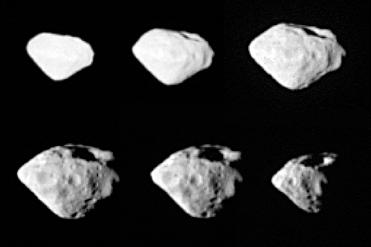
MUNICH (BNS): Spectacular images of Asteroid Steins have been received from European Space Agency’s asteroid chaser Rosetta – from its imaging system and Virtis infrared spectrometer on Wednesday.
Looking at the images sent by Rosetta, Principal Investigator for OSIRIS imaging system from Max Planck Institut Fuer Sonnensystemforschung, Lindau, Uwe Keller said that Steins looks like a diamond in the sky.
A complete analysis of Rosetta data will make Steins, the best-characterised asteroid till date.
Keller said that the images depict the existence of several small craters on the asteroid, and two huge ones, one of which is 2 km in diameter, indicating that the asteroid must be pretty old. “The images are 50 to 60 pixels in diameter, enough to characterise the shape and other characteristics of the asteroid,” Keller said.
Another scientist associated with Rosetta Project, Rita Schulz said, “In the images there is a chain of impact craters, which must have formed from recurring impact as the asteroid rotated. The impact may have been caused by a meteoroid stream, or fragments from a shattered small body.”
Rosetta Mission Manager, Gerhard Schwehm said that Steins looks like a typical asteroid, but it is really fascinating how much we can learn from just the images. “This is our first science highlight; we certainly have a lot of promising science ahead of us. I'm already looking forward to encountering our next diamond in the sky, the much bigger Lutetia,” Schwehm said.
From the images sent by Rosetta, scientists will research to find out why the asteroid is unusually bright, and how fine grains of the surface Regolith are. A study into this will also tell them how asteroids are formed.
Scientists say that according to the images sent by Rosetta there is a chain composed of about seven craters. To determine the age of the asteroid, a count of the craters on the asteroid's surface has been started and till now 23 craters have been marked. Study has confirmed that more number of craters means the older, the asteroid.
Scientists said that the OSIRIS imaging system's Wide Angle Camera (WAC) worked perfectly during the fly-by. They said the images will be retrieved from the Narrow Angle Camera (NAC) and will be compared to learn about the surface composition. It has been noted that NAC appears to have switched to safe mode few minutes before the flyby around Steins and switched on after a few hours. The software is programmed to protect the camera. Once the science data had been analysed, the OSIRIS team will look into this anomaly.
 Previous Article
Previous Article













The Indian Air Force, in its flight trials evaluation report submitted before the Defence Ministry l..
view articleAn insight into the Medium Multi-Role Combat Aircraft competition...
view articleSky enthusiasts can now spot the International Space Station (ISS) commanded by Indian-American astr..
view article